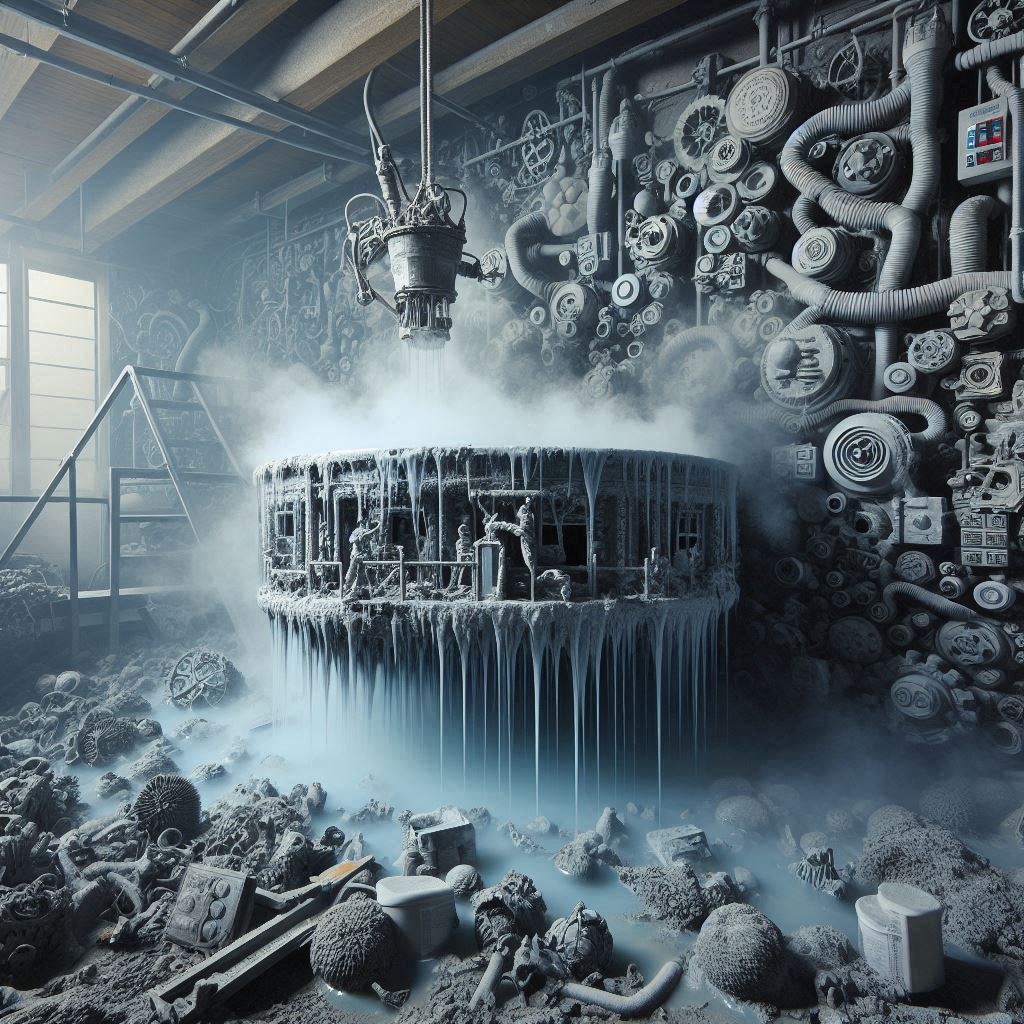
Wondering if fire and heat can truly eliminate mold for good? Well, I’ve got the answers you’ve been searching for. When it comes to battling mold, extreme measures like fire might seem like a quick fix, but is it really effective in eradicating this pesky problem? Let’s delve into the science behind mold removal and whether fire is a viable solution.
As a seasoned expert in the field, I’ve encountered numerous myths and misconceptions surrounding mold remediation. The idea of using fire to combat mold is not only drastic but also potentially dangerous. Join me as we explore the effectiveness of extreme heat in killing mold spores and uncover the best strategies for ensuring your space remains mold-free. Let’s separate fact from fiction and discover the most practical solutions for dealing with mold infestations.
Key Takeaways
- Surface treatments alone may not effectively eliminate mold as roots can penetrate surfaces, making it crucial to address the root cause of moisture for successful remediation.
- Myths like fire and heat completely killing mold are debunked; a comprehensive approach combining various strategies, including extreme heat, is more effective.
- Risks of using fire for mold remediation include structural damage, toxic fumes, and incomplete eradication of mold roots, emphasizing the need for a comprehensive approach.
- Extreme heat (120°F to 190°F) can effectively kill mold spores if maintained for a sufficient duration, but it should be complemented with other methods like moisture control and ventilation.
- Preventing mold growth requires maintaining proper ventilation, monitoring indoor humidity levels, addressing water leaks promptly, inspecting and maintaining the roof, cleaning and drying damp areas, and using mold-resistant products.
Does Thermal Treatment Effectively Eliminate Mold Growth?
Understanding the Science of Mold
Mold is a type of fungus that thrives in damp, dark environments. It reproduces by releasing spores into the air, which can then settle and grow on various surfaces. Mold spores are microscopic and can be easily inhaled, leading to health issues, especially for individuals with allergies or respiratory conditions.
When it comes to addressing mold infestations, it’s crucial to understand that mold roots can penetrate surfaces, making it challenging to completely eradicate mold with surface treatments alone. This is why simply using heat or fire may not effectively eliminate mold. The roots can remain intact, allowing the mold to regrow once conditions are favorable.
Temperature plays a significant role in mold growth. Most molds thrive in temperatures between 60-80°F but can survive and lay dormant at lower temperatures. Exposing mold to high temperatures can inhibit its growth, but it might not always kill it entirely, depending on the duration and intensity of the heat exposure.
In some cases, extreme heat can damage the surfaces mold grows on, potentially causing structural issues. Additionally, using fire to eradicate mold poses serious safety hazards, such as the risk of fire spreading uncontrollably or the production of toxic fumes from burning mold.
To effectively combat mold, it’s essential to address the root cause of moisture, which sustains mold growth. Combining proper ventilation, moisture control, and targeted mold removal methods is key to successful mold remediation. By understanding the science behind mold growth and employing appropriate strategies, it’s possible to effectively manage mold infestations and create a healthier living environment.
Myths and Misconceptions about Mold Remediation
When it comes to mold remediation, there are several myths and misconceptions that can lead to ineffective treatment methods. Let’s debunk some of these common myths:
Myth 1: Fire and Heat Kill Mold Completely
- While it’s true that high temperatures can inhibit mold growth, heat or fire alone are not guaranteed solutions for eradicating mold entirely. Mold roots can be resilient, surviving even in extreme conditions.
Myth 2: Surface Treatments Alone Are Sufficient
- Simply treating the visible mold on surfaces is not enough. Mold often penetrates deep into porous materials, making it crucial to address the root of the issue rather than just the symptoms.
- Effective mold remediation requires more than a one-time treatment. Regular maintenance and vigilance are necessary to prevent mold from returning and spreading.
In tackling mold growth, it’s essential to dispel these myths and adopt a comprehensive approach that addresses the underlying causes of mold infestation.
The Risks of Using Fire to Combat Mold
When it comes to mold remediation, resorting to fire or heat as a solution may seem like a quick fix. However, the reality is that fire alone cannot effectively eliminate mold. In fact, using fire to combat mold poses significant risks that can outweigh any potential benefits.
Here are the key risks of using fire to address mold infestations:
- Structural Damage: Intense heat from fire can cause significant damage to the structure of the building, leading to potential safety hazards.
- Toxic Fumes: Burning mold can release toxic fumes into the air, posing health risks to individuals in the vicinity.
- Incomplete Eradication: Even if the visible mold is burnt away, the roots of the mold can survive, leading to regrowth in the future.
It’s essential to understand that effective mold remediation requires a comprehensive approach that targets the root cause of the issue rather than relying on quick but ineffective solutions like fire.
Effectiveness of Extreme Heat in Killing Mold Spores
When considering mold remediation, it’s crucial to understand the effectiveness of extreme heat in killing mold spores. Heat is indeed effective in eliminating mold, as it can help to destroy mold growth and inhibit spore reproduction. Exposing mold to high temperatures can be a powerful method to address the issue at its source.
Here are some key points to consider regarding the effectiveness of extreme heat in mold remediation:
- Temperature Range: Extreme heat treatments typically involve temperatures ranging from 120°F to 190°F. These high temperatures are aimed at breaking down mold structures and preventing regrowth.
- Kill Rate: Exposing mold spores to temperatures above 140°F for an extended period can kill them effectively. This process helps eradicate mold colonies and prevent future infestations.
- Comprehensive Approach: While extreme heat can be a valuable tool in mold remediation, it’s essential to complement this method with other strategies to address the root cause of mold growth. Combining heat treatments with moisture control and proper ventilation can enhance the overall effectiveness of the remediation process.
Ensuring that the environment reaches the necessary temperature and maintaining it for the required duration are critical factors in the success of using extreme heat for mold remediation. By understanding the effectiveness of extreme heat in killing mold spores, one can implement a more comprehensive approach to remediate mold infestations successfully.
Best Strategies for Preventing Mold Growth
When it comes to preventing mold growth, it’s essential to be proactive and vigilant. Here are some key strategies I recommend to keep mold at bay:
- Maintain proper ventilation: Ensure that your home or property has adequate ventilation in areas prone to moisture buildup, such as bathrooms, kitchens, and basements.
- Monitor indoor humidity levels: Keep indoor humidity levels below 60% to discourage mold growth. Consider using a dehumidifier if needed.
- Address water leaks promptly: Any water leaks or moisture issues should be addressed immediately to prevent mold from taking hold.
- Inspect and maintain your roof: Regularly inspect your roof for any signs of damage or leaks, as roof issues can lead to water seepage and mold growth.
- Clean and dry wet or damp areas: If any areas get wet or damp, it’s crucial to clean and dry them promptly to prevent mold from thriving.
- Use mold-resistant products: Consider using mold-resistant paints, sealants, and materials in moisture-prone areas to proactively combat mold growth.
Conclusion
Extreme heat can be a powerful method for eliminating mold spores and colonies. By exposing mold-infested areas to temperatures between 120°F and 190°F, it’s possible to effectively halt mold growth and prevent spore reproduction. However, it’s essential to remember that heat treatment should be part of a comprehensive mold remediation plan that includes addressing moisture issues and ensuring proper ventilation. Maintaining the required temperature consistently during the treatment process is critical for successful mold eradication. By combining heat treatment with proactive prevention strategies like controlling indoor humidity, fixing leaks promptly, and using mold-resistant materials, you can create a mold-free environment and safeguard your indoor air quality.
Frequently Asked Questions
How effective is extreme heat in killing mold spores?
Extreme heat ranging from 120°F to 190°F is highly effective in destroying mold growth and preventing spore reproduction, effectively eliminating mold colonies.
What is the key to successful mold remediation using extreme heat?
Maintaining the required high temperature for the specified duration is crucial for successful mold eradication using extreme heat treatment.
Besides extreme heat, what other factors are important in mold remediation?
Along with extreme heat treatment, it’s essential to address underlying issues like moisture control and ventilation to prevent mold regrowth.
